What Are the Key Benefits of Upper Body Workouts?
How Often Should I Train My Upper Body?
Warm Up Stretches Before Your Strength Training Session
Most Effective Upper Body Strength Training Exercises
Progress Over Perfection
Want to learn the best upper body strength training exercises that deserve a spot in your routine? Find out which moves are worth your time.
Discover more ways to reach your goals with Peloton
Starting a strength training plan can feel daunting. Where should you start? Which exercises will make the most impact? And how often should you do it? But once you learn the ins and outs of strength training—particularly for your upper body, which tends to be ignored if you’ve generally only focused on cardio in the past—you’ll realize just how enjoyable and empowering strength training can be.
Below, we’ll review the benefits you’ll start to experience when strength training your upper body and help you find a schedule and routine that works for you. (Hint: There’s a Peloton program that’s got you covered.) We’ll also walk you through proper warm-up techniques and the strength training exercises Peloton instructors have found most effective, so you have enough knowledge to safely incorporate this practice into your routine.
What Are the Key Benefits of Upper Body Workouts?
Well, for starters, the benefits of upper body workouts go far beyond any aesthetics. “A strong and healthy upper body allows us greater ease in the practical movements that we find ourselves in every day, like carrying groceries, lifting your child, and getting up off the floor,” explains Peloton instructor Tunde Oyeneyin. Plus, the more your body ages, the more urgent it becomes to focus on building muscle mass. The somewhat harsh (yet also motivating) reality is that muscle mass decreases about 3 to 8 percent per decade after the age of 30, so it's important to continue to load your muscles.
Wherever you are on your fitness journey, by establishing a workout routine that includes consistent upper body exercises and incorporates weights and resistance, you’ll improve your flexibility, help you prevent the risk of injury, and safeguard your shoulders, core, and back.

Peloton App
Access thousands of classes with no equipment needed.
What’s more, strength training increases your resting metabolic rate, according to research published in Current Sports Medicine Reports. So, in addition to improving your flexibility and mobility, strength training is the key to building muscles that will help your body burn more calories—even when you’re just resting.
While upper body workouts can be done simply using your own body weight as the resistance, the added resistance of dumbbells or other weight is the key to getting results you can actually see.
How Often Should I Train My Upper Body?
There are different schools of thought as to how often the upper body should be trained, but at the end of the day, everyone needs to find a routine that’s sustainable for their own body and helps them meet their own goals. If you’re looking to dedicate some time to your upper body, Peloton’s new Upper Body with Tunde program has got you covered. Now available on the Peloton App, the four-week program features three classes per week. Each week, you’ll take push, pull, and core-focused classes, so you can “dedicate more time and energy to each group, promoting muscle hypertrophy or growth, improving recovery between workouts, and allowing a higher level of focus on each group,” says Tunde. Plus, you can easily track your week by week progress with benchmark tests in every class.
No matter how you choose to train, as long as you’re devoting time and energy to your upper body muscle growth at least once a week, you can start to lay a foundation for a routine that accomplishes long-term results.
Warm Up Stretches Before Your Strength Training Session
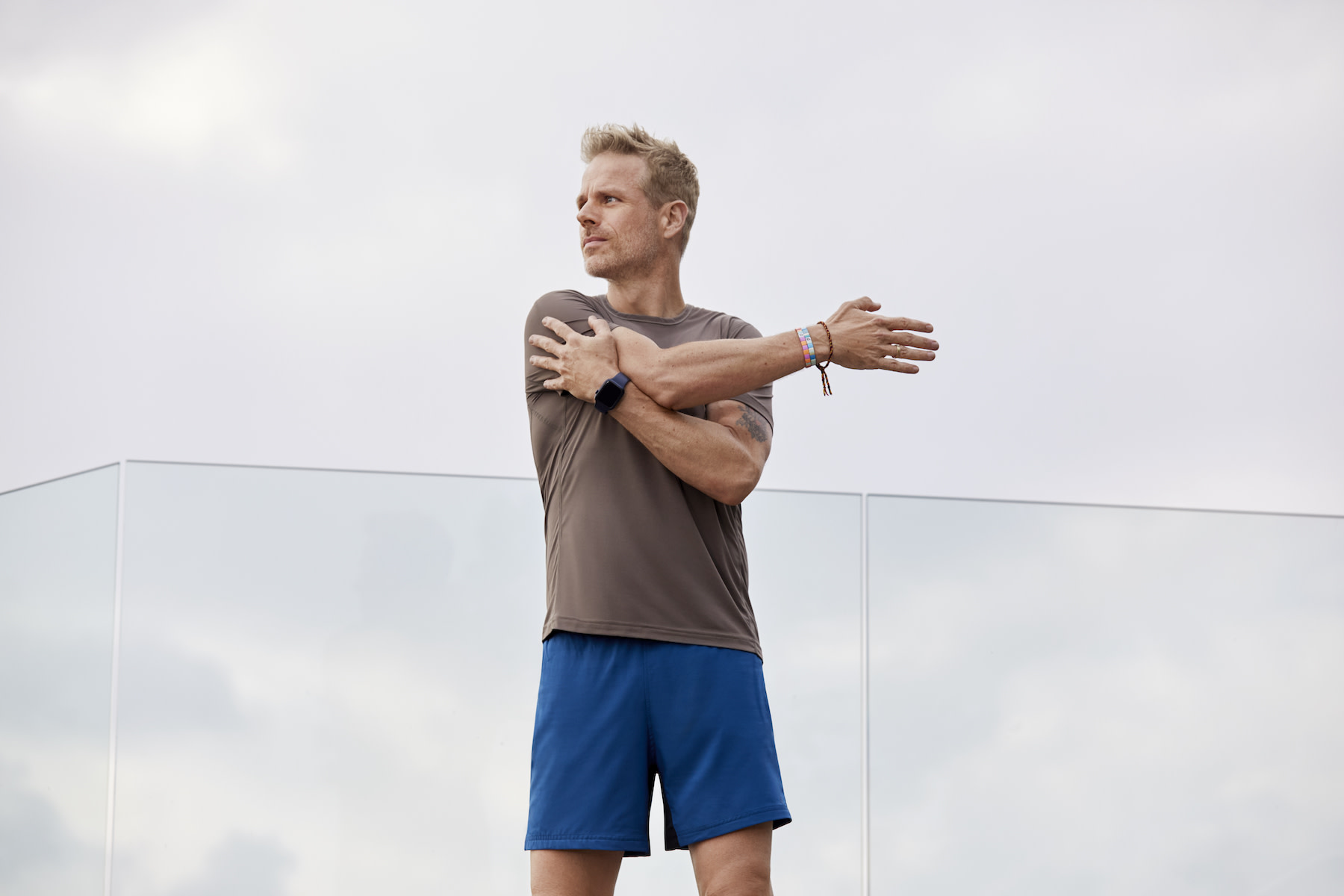
Before you begin your upper body exercises, you need to take some time to properly warm up. This will help you increase your heart rate and get more blood and oxygen flowing to the muscles you’re about to use. You may be tempted to skip this part, but just know that the reward of injury prevention, greater flexibility, and better performance will be worth the extra time. According to the American Council on Exercise, it takes about 8 to 12 minutes to fully warm up, so plan to devote a good amount of time to warming up your upper body muscles before you dive into the weighted exercises further down. Here are a few warm ups to help you get started.
Neck stretch: This warm up will help with any tightness in your shoulders, neck, or upper back. Start out standing. Drop your right ear to your right shoulder and press your left palm toward the floor. Take your right hand and place it gently on your head, over your left temple. Pull down lightly, letting gravity do most of the work, to stretch the neck muscles for about 10 breaths. Repeat on the left side.
Shoulder stretch: This will help relieve tension in your shoulder muscles, increase your mobility, and reduce your risk of shoulder injury. While standing, take one arm and pull it across your chest. Using your other hand, grab onto the outer forearm of your crossed arm, and push it into your body, making sure to keep your elbow right around shoulder height. Hold for 30 seconds, then repeat on your other arm.
Upper body rotation: This warm up will improve your upper body mobility and flexibility. Sitting cross-legged on the floor, rotate your torso to the left, and grab your left knee with your right hand. Place your left hand on the floor behind your body to deepen the stretch. Hold for at least 30 seconds, and then repeat on your right side.
Wrist flexing: This will help you increase your wrist mobility, which will help while holding your weights. Hold your arm straight out in front of you with your palm facing up. Bend your wrist, pointing your palm to the floor and your fingers towards the ceiling. With your other hand, gently pull your fingers back until you feel a mild stretch in your wrist and forearm. Hold for 30 seconds and repeat on both sides a few times.
Jumping jacks: These will help get your heart rate up. Stand with your feet together and arms by your sides. Jump up while spreading your legs, clapping your hands together above your head. On the next jump, return to your starting position. Keep this up for at least 30 seconds.
Most Effective Upper Body Strength Training Exercises
Now that you’ve warmed up, you’re ready to get started. The below exercises are some of the most effective strength training exercises for building upper body strength.
It’s recommended that you also have a few different weight options on hand, but it’s OK to start out nice and light. (And if you’re not sure, Peloton instructor Ben Alldis has tips on how to choose the right weights for your training.)
Overhead Press
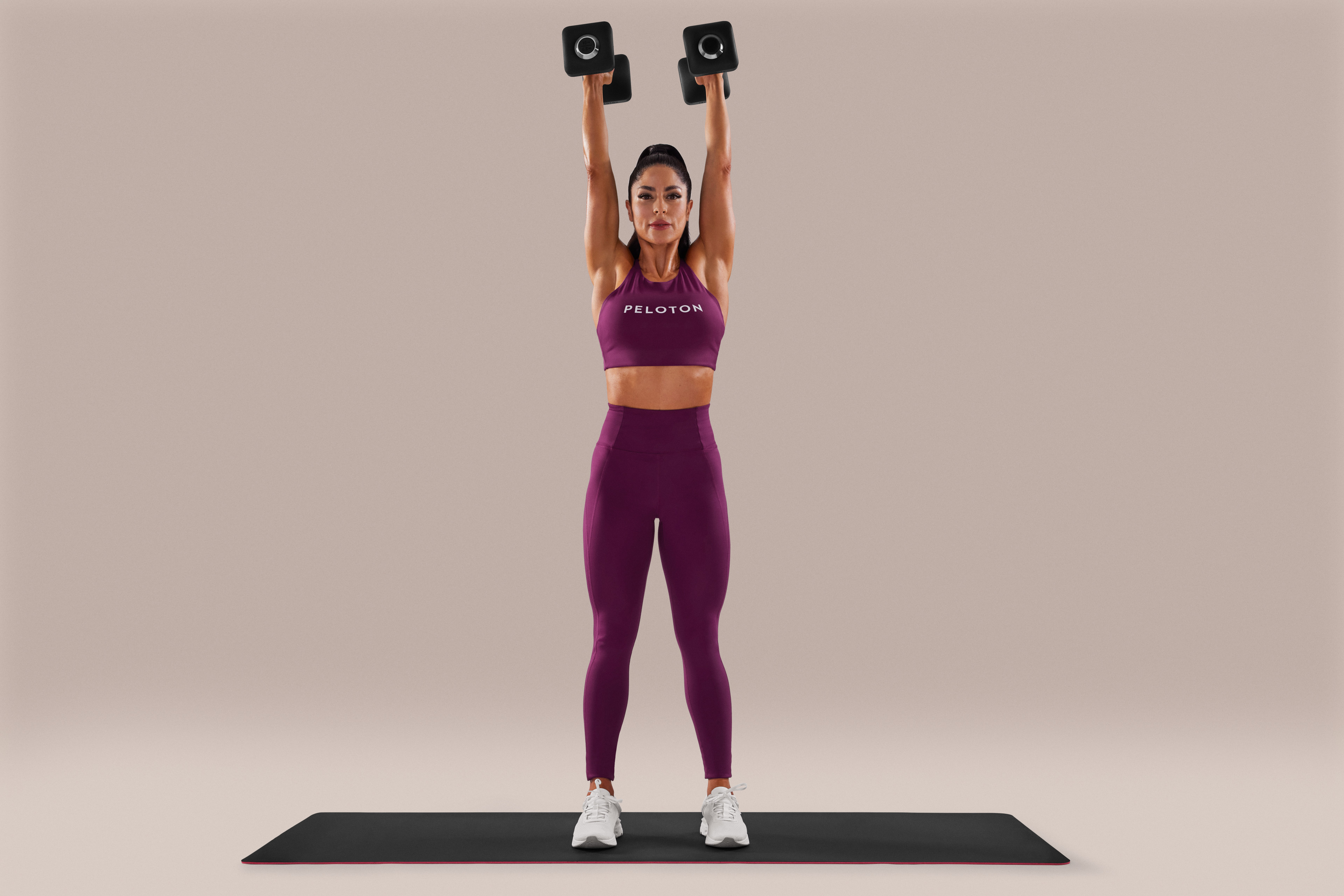
Stand with a straight back. Hold dumbbells with an overhand grip at shoulder height, with thumbs facing inward. Exhale, raising weights above your head in a controlled motion. Pause when your arms are straight (don’t lock your elbows!), then inhale and return the bar/weights to your shoulders.
Muscles worked: Shoulders and core stability
Wide-Grip Chest Press

With your back flat on a mat (or bench), hold dumbbells at your shoulders, with hands above your elbows. Exhale, lifting the weight overhead. Hold for a moment, and then inhale, bringing the weights back to your chest and your hands back to your shoulders.
Muscles worked: Chest, shoulders, and triceps
Skull Crusher

“This is such an excellent move to pump your triceps in a super controlled way,” says Tunde. With your back flat on a mat (or bench), knees bent, hold dumbbells at your shoulders, palms facing in, with arms extended above chest. Flex elbows as you lower hands towards head. Return to start.
Muscles worked: Triceps, forearms, chest
Wide Grip Bent-Over Row
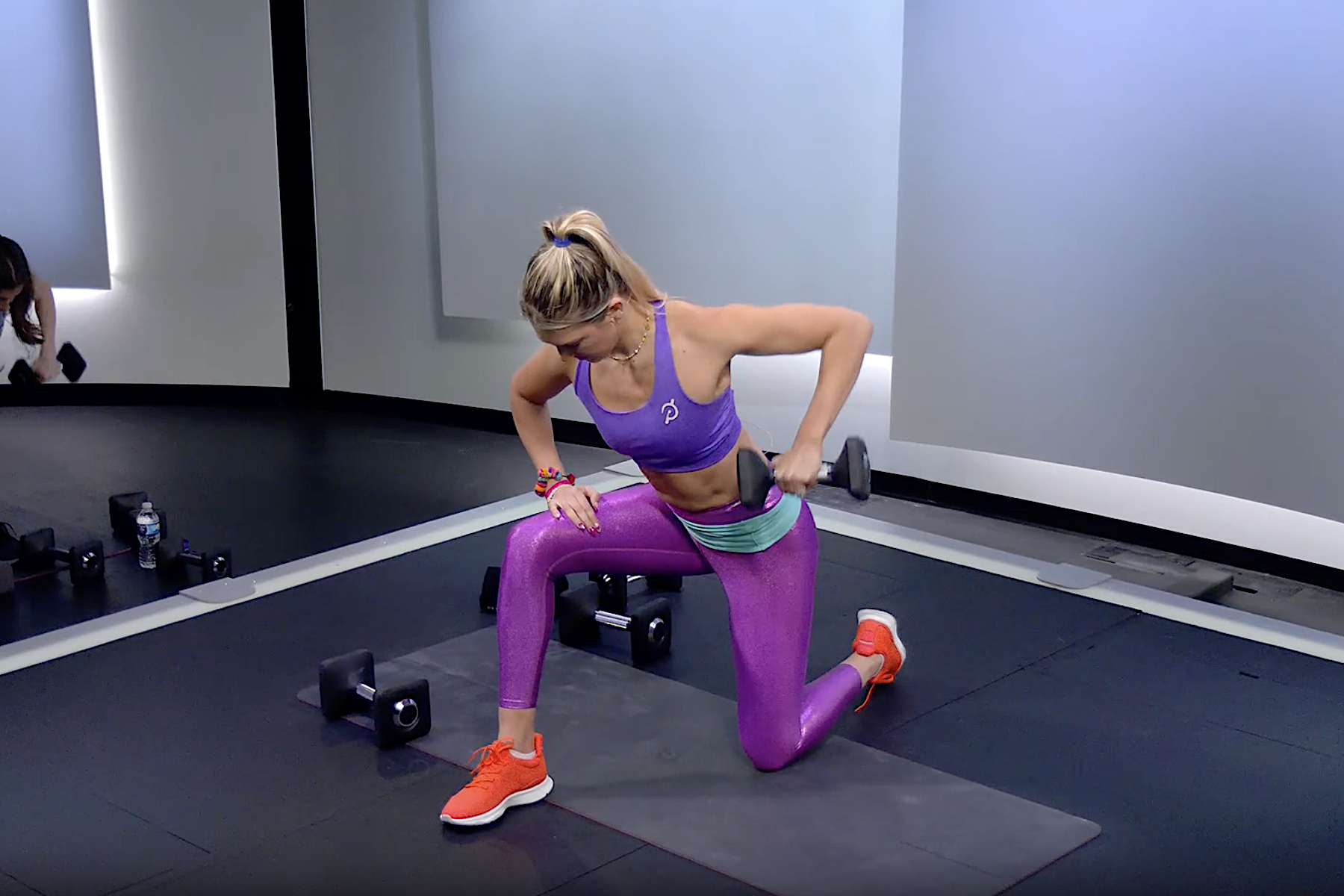
Hold your heavier dumbbells with an overhand grip, keeping your hands shoulder-width apart. With a straight back and legs slightly bent, bend your upper body until it’s perpendicular to the ground. (To modify, lower back knee to the ground as pictured above.) Keeping your elbows wide and palms facing your body, row the dumbbells towards your chest on an exhale. Hold it for a breath, then inhale, returning to starting position.
Muscles worked: Mid back, shoulders, lats, and biceps
Biceps Curl

Hold your heavier dumbbells with an underhand, shoulder-width grip by your sides. Exhale, curling the weight to your chest, keeping your upper arms stationary, elbows at sides. Pause, then lower back to the starting position.
Muscles worked: Biceps and forearms
Front Raise

Stand with feet shoulder-width apart, knees slightly bent. Relax your shoulders and hold light to medium dumbbells at the top of your thighs, palms facing your body.
With elbows slightly bent, and exhale as you raise your arms to shoulder height. Pause at the top, then inhale as you lower the weight back to start.
Muscles worked: Shoulders, chest, biceps
Dumbbell Hammer Curl
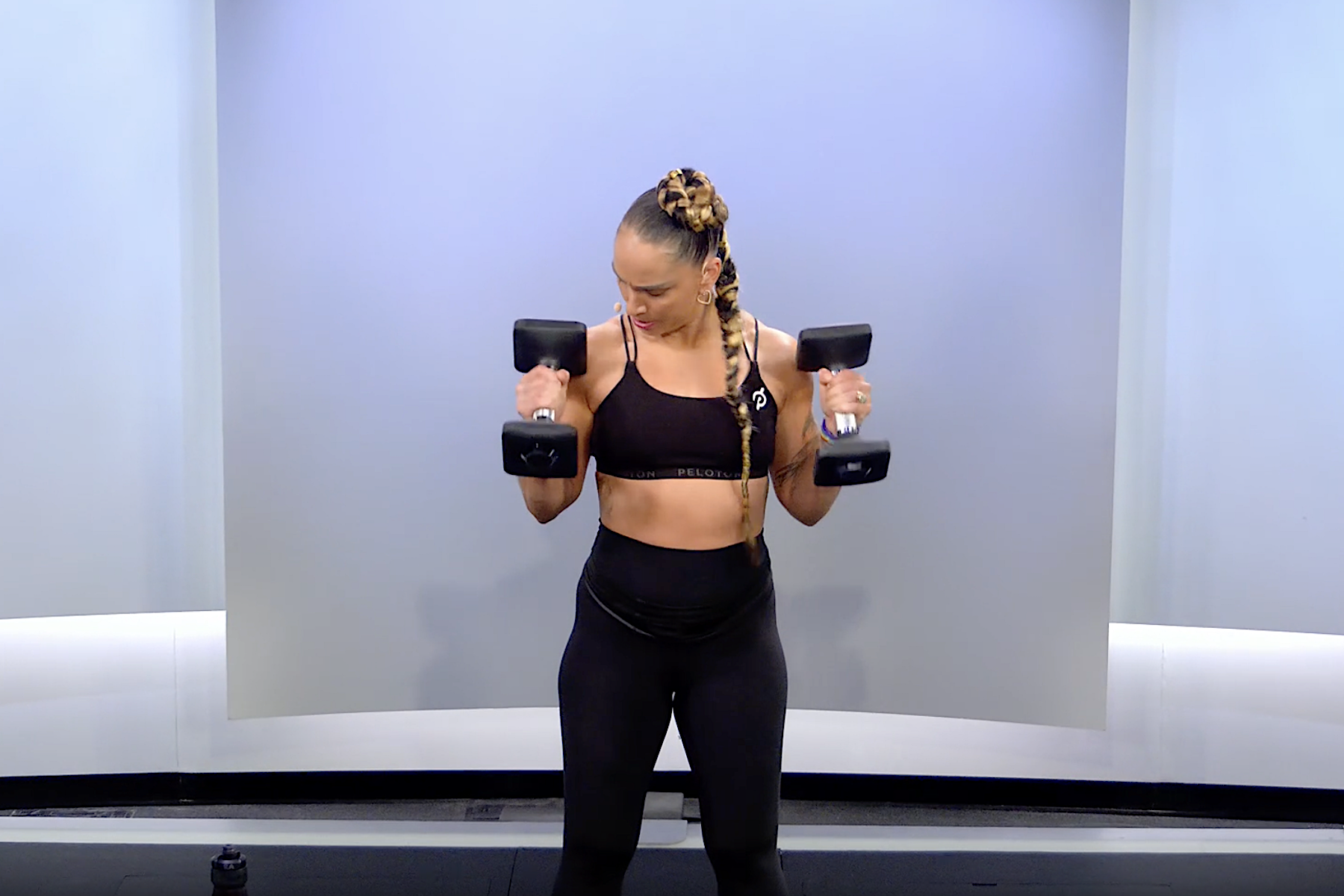
Stand with feet shoulder-width apart, knees slightly bent. Relax your shoulders and hold your arms at your side, palms facing in. Bend your elbows, exhale, and pull the weights toward your shoulders. Hold them there for a breath, then lower the weights on your inhale.
Muscles worked: Biceps
Single-Arm Dumbbell Row
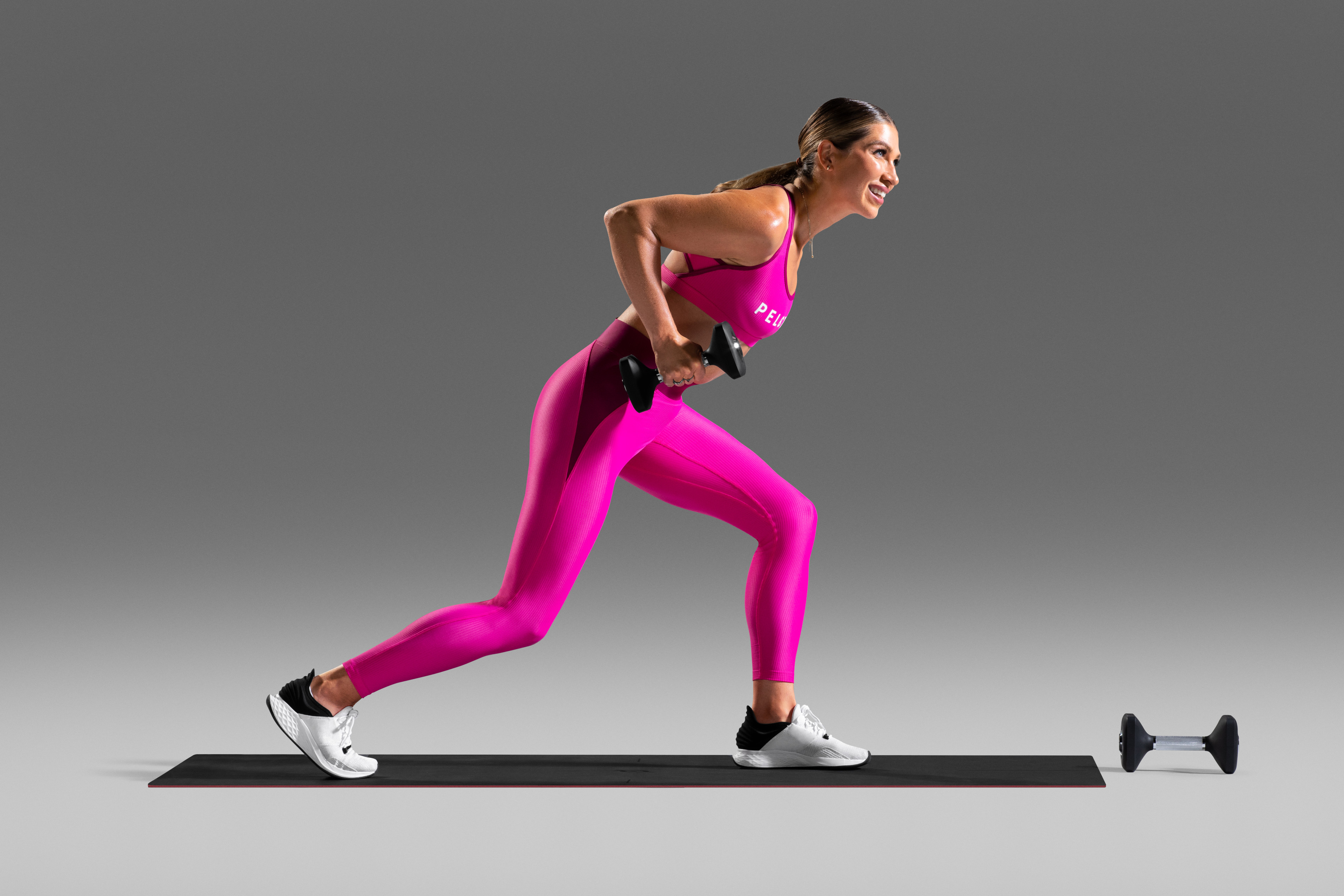
From standing with a dumbbell in one hand at your side, step the opposite foot back into a lunge. Lean chest slightly forward and place free hand on thigh. Dumbbell should be in line with front knee. Engage your back and shoulder as you drive elbow back towards ceiling, bringing dumbbell in line with chest. Return to start. Switch sides; repeat.
Muscles worked: Back, shoulders, triceps
Progress Over Perfection
By incorporating these moves into your routine, you can make upper body strength training a consistent part of your workouts. It’s important to remember that you can start small. Doing just one or two of these upper body exercises, along with your current routine is a great place to start. “Show yourself grace just for showing up,” advises Tunde. “Building strength is a lifelong journey that takes time and consistency, so don’t be afraid to modify movements or drop weight as you need.”
And above all, make sure you find a way to embrace the process and appreciate the small wins as you find the upper body strength training routine that works best for you.
Related Articles
This content is for informational and educational purposes only and does not constitute individualized advice. It is not intended to replace professional medical evaluation, diagnosis, or treatment. Seek the advice of your physician for questions you may have regarding your health or a medical condition. If you are having a medical emergency, call your physician or 911 immediately.
Level up your inbox.
Subscribe for a weekly dose of fitness, plus the latest promos, launches, and events.
By providing your email address, you agree to receive marketing communications from Peloton.
For more about how we use your information, see our Privacy Policy.















